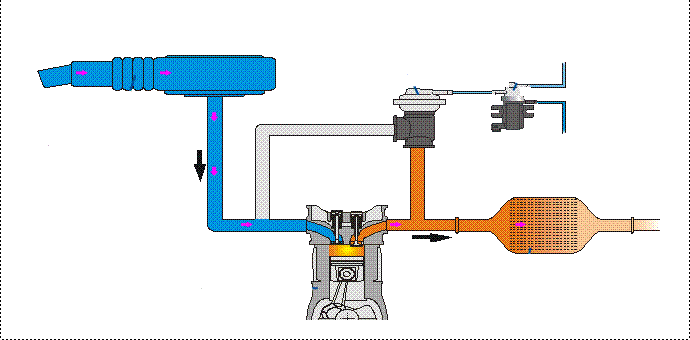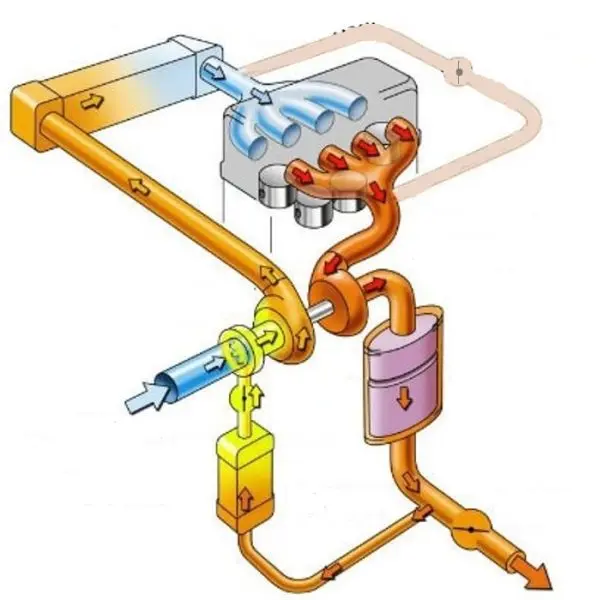
Exhaust gas recirculation system
Content
With the increasing requirements of environmental standards, additional systems are gradually added to a modern car that change the operating modes of the internal combustion engine, adjust the composition of the air-fuel mixture, neutralize hydrocarbon compounds contained in the exhaust, etc.
Such devices include catalytic converter, adsorber, AdBlue and other systems. We have already spoken about them in detail. Now we will focus on one more system, which every motorist is obliged to monitor the health of. This is exhaust gas recirculation. Let's consider what the drawing of the system looks like, how it works, what types there are, and also what advantages it has.
What is a car gas recirculation system
In technical literature and in the description of the car, this system is called EGR. The decoding of this abbreviation from English literally means "exhaust gas recirculation". Without going into the details of various system modifications, in fact, this is a recirculation valve that is installed on the pipe connecting the intake and exhaust manifolds.
This system is installed on all modern engines equipped with an electronic control unit. Electronics allows you to more accurately adjust various mechanisms and processes in the power unit, as well as in systems whose work is closely related to the operation of the internal combustion engine.
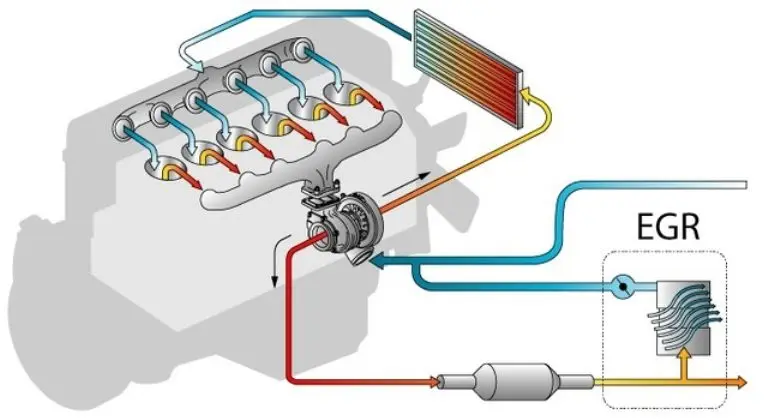
At a certain moment, the EGR flap opens slightly, due to which the exhaust partially enters the engine intake system (for more information about the device and the principle of its operation, read in another review). As a result, the fresh air stream is partially mixed with the exhaust gas. In this regard, the question arises: why do you need exhaust gases in the intake system, if a sufficient amount of oxygen is needed for the efficient operation of the engine? If there is a certain amount of unburned oxygen in the exhaust gases, the lambda probe can show this (it is described in detail here). Let's try to deal with this seeming contradiction.
Purpose of the exhaust gas recirculation system
It is no secret to anyone that when the fuel and air compressed in the cylinder burns, not only decent energy is released. This process is accompanied by the release of a large amount of toxic substances. The most dangerous of these are nitrogenous oxides. Partially they are fought by a catalytic converter, which is installed in the exhaust system of a car (what elements does this system consist of, and how does it function, read separately).
Another possibility to reduce the content of such substances in the exhaust is to change the composition of the air-fuel mixture. For example, the electronic control unit increases or decreases the amount of fuel injected into the fresh portion of air. This is called MTC impoverishment / enrichment.
On the other hand, the more oxygen enters the cylinder, the higher the combustion temperature of the air / fuel mixture. During this process, nitrogen is released from the combination of the thermal decomposition of gasoline or diesel fuel and high temperatures. This chemical element enters into an oxidative reaction with oxygen, which did not have time to burn. Moreover, the rate of formation of these oxides is directly related to the temperature of the working environment.
The purpose of the recirculation system is precisely to reduce the amount of oxygen in the fresh portion of air. Due to the presence of a small amount of exhaust gas in the composition of the VTS, a slight cooling of the combustion process in the cylinders is provided. In this case, the energy of the process itself does not change, since the same volume continues to flow into the cylinder, which contains the amount of oxygen required to ignite the fuel.

The gas flow is conventionally considered inert, since it is a product of the combustion of HTS. For this reason, by itself, it is no longer capable of burning. If a certain amount of exhaust gases is mixed into a fresh portion of the air-fuel mixture, the combustion temperature will slightly decrease. Due to this, the process of nitrogen oxidation will be less active. True, recirculation slightly reduces the power of the power unit, but the car retains its dynamism. This disadvantage is so insignificant that it is almost impossible to notice the difference in ordinary transport. The reason is that this process does not occur at the power modes of the internal combustion engine, when its speed rises. It only works at low and medium rpm (in gasoline units) or idle and low rpm (in the case of diesel engines).
So, the purpose of the EGR system is to reduce the toxicity of the exhaust. Thanks to this, the car has more chances to fit into the framework of environmental standards. It is used on any modern internal combustion engine, regardless of whether it is gasoline or diesel. The only caveat is that the system is not compatible with some units that are equipped with turbochargers.
General operating principles of the exhaust gas recirculation system
Although today there are several types of systems in which the connection of the exhaust manifold to the inlet through a pneumatic valve is realized, they have a common principle of operation.
The valve will not always open. When a cold engine starts, runs at idle, and also when it reaches maximum crankshaft speed, the throttle must remain closed. In other modes, the system will operate, and the combustion chamber of each cylinder-piston group will receive a small amount of fuel combustion products.
If the device will operate at idle speed of the engine or in the process of reaching its operating temperature (about what it should be, read here), the unit will become unstable. The maximum efficiency of the EGR valve is achieved only when the engine is running at close to average rpm. In other modes, the concentration of nitrogen oxides is much lower.
When the engine is warming up, the combustion temperature in the chambers is not so high that a large amount of nitrous oxides are formed, and the return of a small amount of exhaust to the cylinders is not necessary. The same happens at low speeds. When the engine reaches maximum speed, it should develop maximum power. If the valve is triggered, it will only interfere, therefore, in this mode, the system will be in an inactive state.
Regardless of the type of systems, the key element in them is a flap that blocks the access of exhaust gases to the intake system. Since the high temperature of the gas stream takes up more volume than the cooled analogue, the exhaust gas needs to be cooled so that the combustion efficiency of the HTS does not decrease. For this, there is an additional cooler or intercooler associated with the engine cooling system. The circuit in each car model may be different, but it will have a radiator that stabilizes the process of maintaining the optimum temperature for the device.
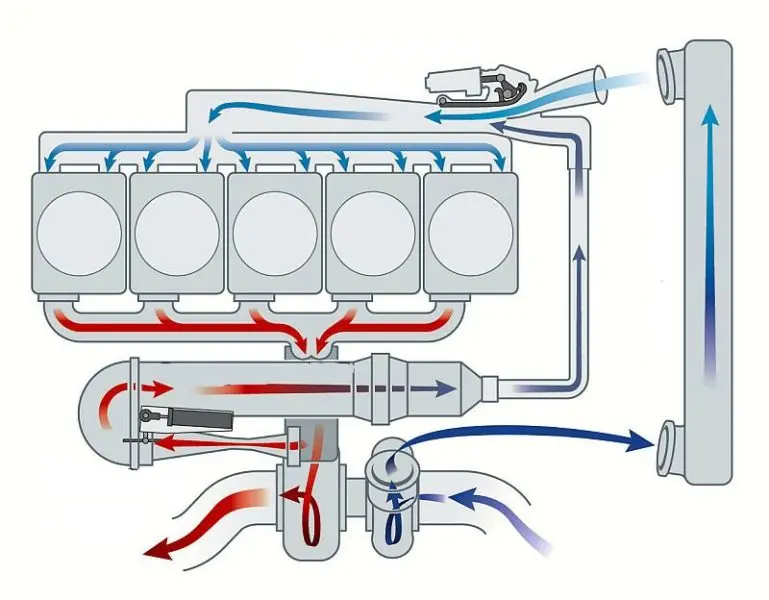
As for diesel engines, the valve in them is open at XX. The vacuum in the intake system draws the exhaust gas into the cylinders. In this mode, the engine receives about 50 percent of the exhaust gases (in relation to fresh air). As the speed increases, the damper actuator gradually moves it to the closed position. This is basically how diesel works.
If we talk about a gasoline unit, then a high concentration of exhaust gases in the intake tract is fraught with poor operation of the internal combustion engine. Therefore, in this case, the operation of the system is slightly different. The valve opens when the engine reaches medium speed. Moreover, the content of exhaust in a fresh portion of BTC should not exceed 10 percent.
The driver learns about incorrect regeneration by the Check Engine signal on the dashboard. Here are the main breakdowns that such a system can have:
- The flap opening sensor has broken. Usually, apart from an incorrect dosage and a light bulb that lights up on the tidy, nothing critical happens.
- Damage to the valve or its sensor. The main reason for this malfunction is constant contact with hot gases coming out of the motor. Depending on the type of system, the breakdown of this element may be accompanied by depletion or vice versa enrichment of the MTC. If the engines use a combined system equipped with sensors such as MAF and MAP, then at idle the mixture becomes excessively rich, and at high crankshaft speed, the BTC is dramatically leaner.
When the system fails, gasoline or diesel burns poorly, due to which accompanying malfunctions occur, for example, the working life of the catalyst is sharply reduced. This is how the behavior of the motor looks in practice with a faulty exhaust gas return mechanism.
To stabilize idle speed, the control unit adjusts the operation of the fuel system and ignition (if it is a gasoline unit). However, he cannot cope with this task in the transient mode, since opening the throttle greatly increases the vacuum, and the exhaust pressure rises sharply, due to which more exhaust gas flows through the open damper.
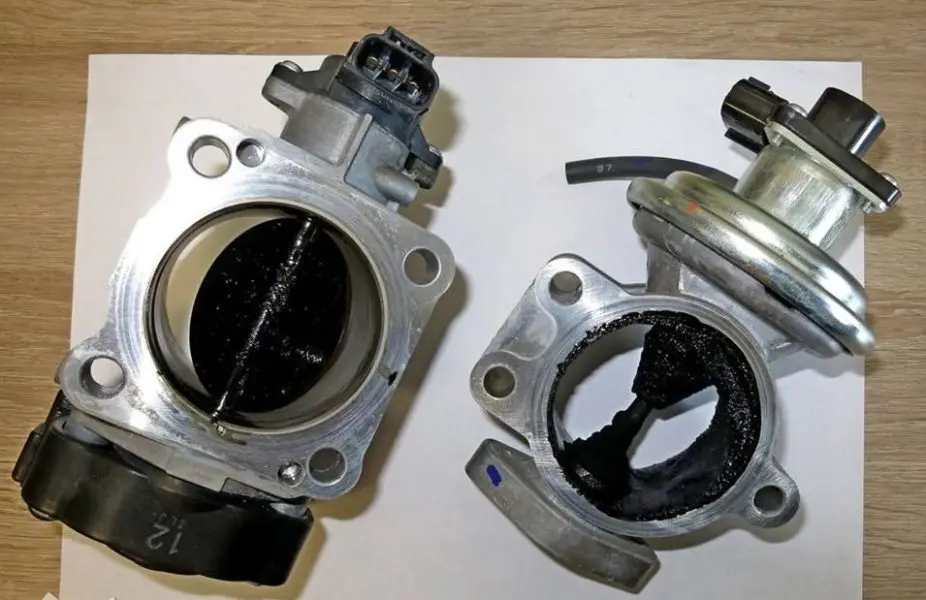
As a result, the engine does not receive the amount of oxygen that is necessary for complete combustion of fuel. Depending on the degree of breakdown, the car may jerk, misfire, instability or complete absence of XX, the internal combustion engine may start poorly, etc.
Mist lubrication is present in the intake manifold of the unit. With its constant contact with hot exhaust gases, the inner surfaces of the manifold, valves, the outer surface of the injectors and spark plugs will quickly become covered with carbon deposits. In some cases, fuel ignition can occur before the BTC enters the cylinder (if you press the accelerator pedal sharply).
As for the unstable idle speed, in the event of a failure of the Ugr valve, it can either completely disappear, or it can rise to critical limits. If the car is equipped with an automatic transmission, then the motorist in the second case will soon have to spend money on the automatic transmission repair. Since each manufacturer implements the exhaust gas recirculation process in its own way, the malfunction of this system is individual in nature. Also, the consequences of this are directly influenced by the technical condition of the power unit, ignition system, and fuel system.
Disabling the system will make the diesel engine work harder at idle. A gasoline engine will experience inefficient fuel consumption. In some cases, the catalyst clogs up faster due to the large amount of soot that appears as a result of using an incorrect air-fuel mixture. The reason is that the electronics of a modern car are designed for this system. To prevent the control unit from making an amendment for the recirculation, you need to rewrite it, as with chip tuning (read about this procedure here).
Recirculation system types
In a modern car, one of three types of EGR systems can be installed on the power unit:
- In accordance with Euro4 eco-standard. This is a high pressure system. The flap is located directly between the intake and exhaust manifolds. At the exit from the motor, the mechanism stands in front of the turbine. In this case, an electro-pneumatic valve is used (previously, a pneumatic-mechanical analogue was used). The action of such a scheme is as follows. Throttle valve closed - the engine is idling. The vacuum in the intake tract is small, so the flap is closed. When you press the accelerator, the vacuum in the cavity increases. As a result, back pressure is created in the intake system, due to which the valve opens completely. A certain amount of exhaust gas is returned to the cylinders. In this case, the turbine will not work, since the exhaust gas pressure is low, and they cannot spin its impeller. Pneumatic valves do not close after opening until the motor speed drops to the appropriate value. In more modern systems, the recirculation design includes additional valves and sensors that adjust the process in accordance with the motor modes.

- In accordance with Euro5 eco-standard. This system is low pressure. In this case, the design is slightly modified. The damper is located in the area behind the particulate filter (about why it is needed, and how it works, read here) in the exhaust system, and in the intake - in front of the turbocharger. The advantage of such a modification is that the exhaust gases have time to cool slightly, and due to their passage through the filter, they are cleared of soot and other components, due to which the device in the previous system has a shorter working life. This arrangement provides exhaust gas return also in turbocharging mode, since the exhaust completely passes through the turbine impeller and spins it up. Thanks to such a device, the system does not reduce the engine power (as some motorists say, it does not "choke" the engine). In many modern car models, the particulate filter and catalyst are regenerated. Due to the fact that the valve and its sensor are located farther from the thermally loaded unit of the car, they do not often fail after several such procedures. During regeneration, the valve will be closed as the engine requires additional fuel and more oxygen to temporarily raise the temperature in the DPF and burn off the soot it contains.

- In accordance with Euro6 eco-standard. This is a combined system. Its design consists of elements that are part of the devices described above. Since each of these systems operates only in its own mode, the intake and exhaust systems of the internal combustion engine are equipped with valves from both types of recirculation mechanisms. When the pressure in the intake manifold is low, a stage typical for the Euro5 (low pressure) indicator is triggered, and when the load increases, the stage is activated, which is used in cars that comply with the Euro4 (high pressure) eco standard.
This is how systems work that belong to the type of external recirculation (the process takes place outside the power unit). In addition to it, there is a type that provides an internal supply of exhaust gases. It is able to work off part of the exhaust as if it were entering the intake manifold. Only this process is ensured by slightly cranking the camshafts. For this, a phase shifter is additionally installed in the gas distribution mechanism. This element, in a certain operating mode of the internal combustion engine, slightly changes the valve timing (what it is, and what value they have for the engine, it is described separately).
In this case, both valves of the cylinder open at a certain moment. The exhaust gas concentration in the fresh BTC portion depends on how long these valves are open. During this procedure, the inlet opens before the piston reaches top dead center and the outlet closes just before the TDC of the piston. Due to this short period, a small amount of exhaust flows into the intake system and is then sucked into the cylinder as the piston moves towards BDC.
The advantage of this modification is a more even distribution of exhaust gas in the cylinders, as well as the speed of the system is much higher than in the case of external recirculation.
Modern recirculation systems include an additional radiator, the heat exchanger of which allows the exhaust gas to be quickly cooled before it enters the intake tract. It is impossible to specify the exact configuration of such a system, since car manufacturers implement this process according to different schemes, and additional control elements may be located in the device.
Gas recirculation valves

Separately, mention should be made of the varieties of EGR valves. They differ from each other in the way they are governed. According to this classification, all mechanisms are divided into:
- Pneumatic valves. This type of device is rarely used anymore. They have a vacuum principle of operation. The flap is opened by the vacuum generated in the intake tract.
- Electro-pneumatic. An electrovalve controlled by an ECU is connected to the pneumatic valve in such a system. The electronics of the on-board system analyzes the modes of the motor, and accordingly adjusts the operation of the damper. The electronic control unit receives signals from sensors for temperature and air pressure, coolant temperature, etc. and, depending on the received data, activates the electric drive of the device. The peculiarity of such valves is that the damper in them is either open or closed. The vacuum in the intake system can be created by an additional vacuum pump.
- Electronic. This is the most recent development of mechanisms. The solenoid valves work directly from the signals from the ECU. The advantage of this modification is their smooth operation. It is achieved through three damper positions. This allows the system to automatically adjust the exhaust gas dose in accordance with the internal combustion engine mode. The system does not use vacuum in the intake tract to control the valve.
Recirculation system benefits
Contrary to popular belief that a vehicle's environmental friendliness system is not beneficial to the powertrain, exhaust gas recirculation has some benefits. Someone may not understand why install a system that reduces the power of the internal combustion engine, if additional neutralizers can be used (but in this case, the exhaust system will literally be "golden", since precious metals are used to neutralize toxic substances). For this reason, the owners of such machines are sometimes set to disable the system. Despite the seeming disadvantages, exhaust gas recirculation is even somewhat beneficial to the power unit.

Here are some reasons for this process:
- In a gasoline engine, due to the low octane number (about what it is, and what role this parameter affects on the internal combustion engine, read separately) fuel detonation often occurs. The presence of this malfunction will be indicated by the sensor of the same name, which is described in detail here... The presence of a recirculation system eliminates this negative effect. Despite the seeming contradiction, the presence of an egr valve, on the contrary, makes it possible to increase the power of the unit, for example, if you set a different ignition timing for an earlier ignition.
- The next plus also applies to gasoline engines. In the throttle of such ICEs, there is often a large pressure drop, due to which there is a small loss of power. The operation of recirculation makes it possible to reduce this effect as well.
- As for diesel engines, in the XX mode, the system provides a softer operation of the internal combustion engine.
- If the car passes environmental control (for example, when crossing the border with the EU countries, this procedure is mandatory), then the presence of recycling increases the chances of passing this check and getting a pass.
In most auto models, the recirculation system is not so easy to turn off, and in order for the engine to work stably without it, additional settings of the electronic control unit will need to be made. Installing other software will prevent the ECU from responding to the lack of signals from the EGR sensors. But there are no such factory programs, so changing the electronics settings, the car owner acts at his own peril and risk.
In conclusion, we offer a short animated video on how recirculation works in the motor:
Questions and answers:
How to check the EGR valve? The valve contacts are energized. A click should be heard. Other procedures depend on the installation site. Basically, it is required to slightly press the vacuum membrane while the engine is running.
What is an EGR valve for? This is an element necessary to reduce the content of harmful substances in the exhaust (some of the gases are directed to the intake manifold) and to increase the performance of the unit.
Where is the EGR valve located? It depends on the design of the motor. You need to look for it in the area of the intake manifold (on the manifold itself or on the pipeline that connects the intake to the engine).
How does an exhaust valve work? When the throttle is opened more, due to the pressure difference in the intake and exhaust manifolds, part of the exhaust gas is sucked into the intake system of the internal combustion engine through the EGR valve.


